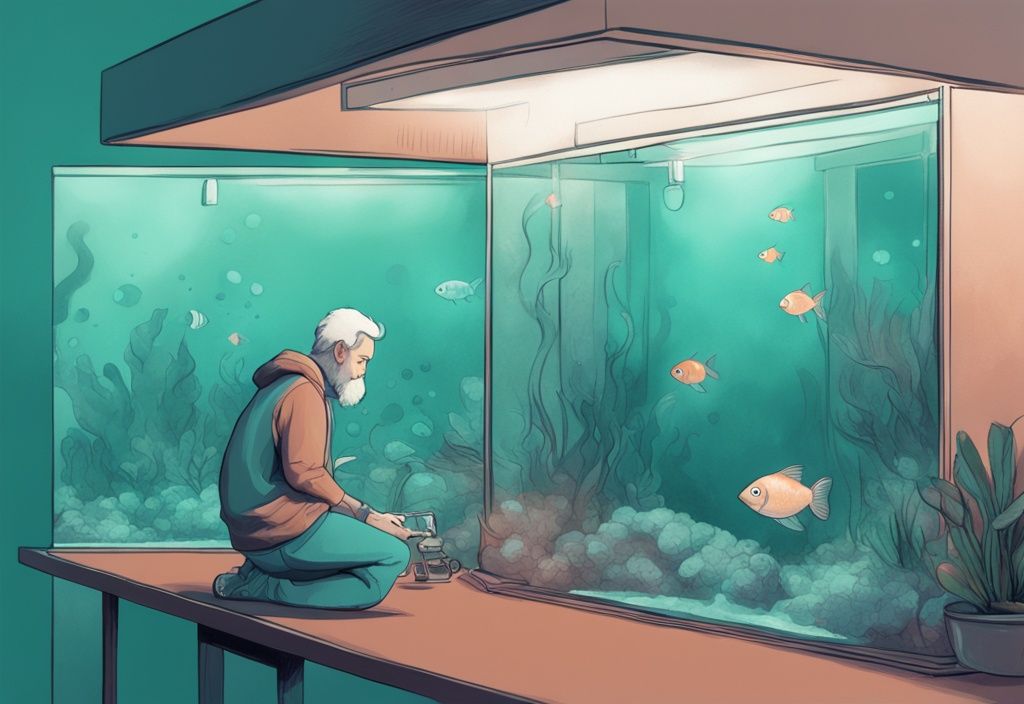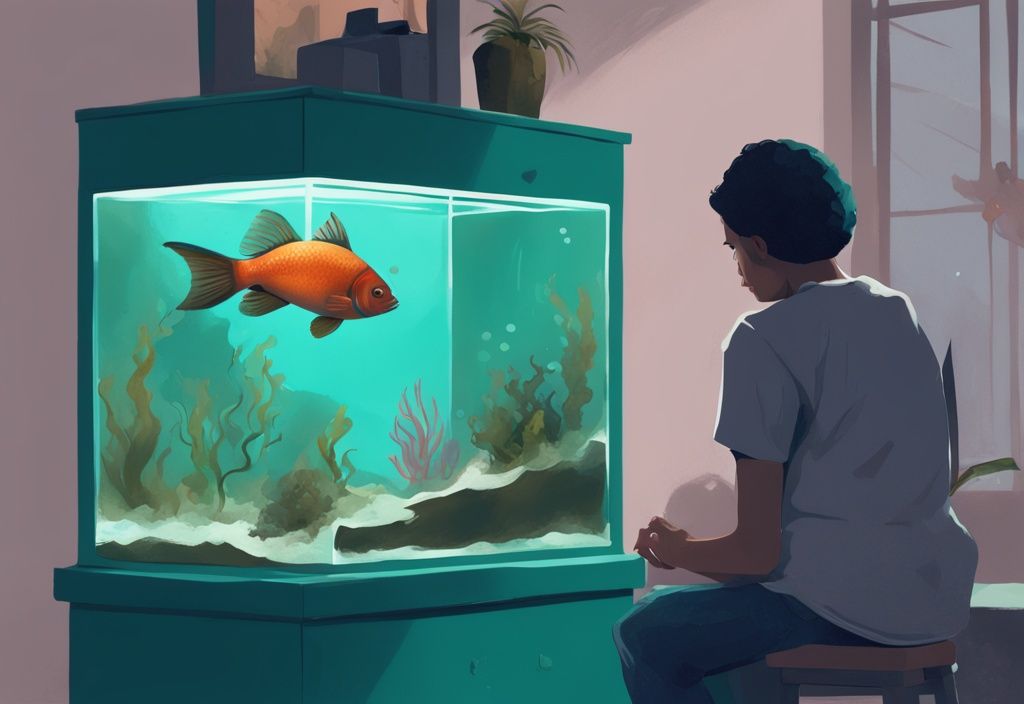In the vast ocean of aquarium experiences, isn’t it rather perplexing when your brand-new fish tank becomes cloudy just after a day? As an experienced marine biologist, I’m here to help you navigate these murky waters. This issue is more common than you would think, and there’s an array of potential culprits behind it – ranging from bacterial blooms to unwashed gravel.
In this compact guide, we’ll dive headfirst into the various reasons causing the cloudiness in your fish tank and, more importantly, how to remedy the situation swiftly.
Ensuring a healthy aquatic environment requires a bit of detective work, but don’t worry – it’s a thrilling investigation. By the end of this article, you’ll have gained the necessary insights to maintain crystal clear water for your aquatic friends, and keep your fish tank thriving day after day.
Key Reasons Why Your New Fish Tank is Cloudy
When you notice your fish tank becoming cloudy just after a day of setting it up, there are several factors at play. From bacterial blooms and microscopic organisms to gravel residue and overfeeding, each element can contribute to the murkiness. Understanding these reasons can help in establishing a clearer, healthier environment for your aquatic life.
Bacterial Bloom: A Common Cause
Encountering cloudy water within the first day of setting up an aquarium is often due to a bacterial bloom. This phenomenon occurs as the tank attempts to establish its biological balance, with beneficial nitrifying bacteria yet to fully colonize. These bacteria are crucial for breaking down waste products and maintaining a healthy environment, but their initial scarcity can lead to water cloudiness.
The bacterial population stabilizes over the following days, eventually clearing the cloudiness. So, when pondering “why is my fish tank cloudy after 1 day,” this natural and temporary bacterial bloom during the tank’s early stages is often the answer.
Are Microscopic Organisms Clouding Your Aquarium?
In the initial days of a new tank, free-floating bacteria and other microscopic organisms can swiftly proliferate. These tiny creatures feed on the abundant minerals and nutrients present in the water, resulting in noticeable cloudiness. This rapid growth is part of the tank’s early lifecycle as it seeks equilibrium.
The presence of these bacteria and microorganisms is another common explanation for “why is my fish tank cloudy after 1 day,” underscoring the dynamic nature of new aquatic ecosystems.
How Gravel Residue Contributes to Cloudiness
A common oversight during new aquarium setups is insufficient rinsing of the gravel. Unwashed gravel can harbor residue and dust, which can cause significant cloudiness when introduced into the water. This initial turbidity is often one of the first signs noticed by new aquarium owners.
Properly washing the gravel before adding it to the tank can prevent this issue, leading to a clearer start and addressing one possible cause of “why is my fish tank cloudy after 1 day.”
Can Overfeeding and Overstocking Cause Murky Water?
Overfeeding and overstocking are other culprits behind cloudy water in new aquariums.
Introducing too many fish at once or overfeeding can overwhelm the tank’s developing ecosystem. Excess food and increased waste provide nutrients for bacteria, worsening the cloudiness.
Overstocking leads to an increase in biological waste that the tank’s nascent filtration system might struggle to handle. Monitoring feeding practices and stocking levels is crucial in the tank’s early days to prevent these issues and understand “why is my fish tank cloudy after 1 day.”
Why New Water May Make Your Aquarium Cloudy
Even the new water itself can contribute to temporary cloudiness. Fresh water often takes time to settle and clear up, causing initial murkiness that may concern new aquarists. Performing water changes in these early stages might offer temporary relief but can also introduce new nutrients that feed bacteria.
The tank cycling process, a critical component of establishing a healthy aquarium, inherently involves cloudiness as nitrifying bacteria take hold. Understanding this helps in grasping “why is my fish tank cloudy after 1 day,” and patience becomes key, as this cloudiness is a natural part of creating a stable and thriving aquatic environment. For those looking to maintain a pristine tank, exploring the best fish tank gravel cleaner options can be beneficial.

Effective Solutions to Clear Cloudy Water in a Fish Tank
When your fish tank becomes cloudy after just one day, it can be quite perplexing. This is often due to a phenomenon known as a bacterial bloom, triggered by an imbalance in the aquarium’s ecosystem. Fortunately, there are several reliable methods you can use to clear up this cloudiness. Below, I’ve compiled a list of practical solutions that address this common issue.
How Live Plants Can Help Clear Your Aquarium
Integrating live plants into your aquarium is an excellent solution when asking, “why is my fish tank cloudy after 1 day?” Live plants absorb excess nutrients, which otherwise fuel bacterial blooms causing water cloudiness. By competing with bacteria for these nutrients, plants help stabilize the aquarium environment.
Additionally, live plants produce oxygen through photosynthesis, further enhancing water clarity. Incorporating a variety of aquatic plants not only beautifies the tank but also creates a balanced ecosystem that aids in maintaining clear water.
Does Filter Cleaning Clear Cloudy Water?
Initial filter cleaning in the first 30 days of setting up a new aquarium is discouraged because it disrupts the establishment of crucial beneficial bacteria. These bacteria are integral to maintaining the nitrogen cycle, which keeps water clear.
Instead, focus on regular tank maintenance to manage cloudiness. This includes vacuuming the substrate to remove debris and performing modest water changes. If you’re concerned about your tank’s water chemistry, you might also want to learn how to lower GH in your aquarium to maintain a healthy environment. Establishing a weekly routine ensures waste accumulation is minimized, contributing to a clearer tank. Proper maintenance routines are essential in resolving the question, “why is my fish tank cloudy after 1 day?”
The Role of Activated Carbon Media in Clearing Haze
Activated carbon media is highly effective in managing aquarium cloudiness, particularly during the early days when you might wonder, “why is my fish tank cloudy after 1 day?” Activated carbon works by absorbing dissolved organic compounds that contribute to water cloudiness.
By placing activated carbon pads or media in the filter, these compounds are removed, resulting in clearer water. Activated carbon targets many of the particles and impurities that cloud the water, making it an indispensable tool for maintaining water clarity.
How to Use Water Clarifiers for a Clear Aquarium
Water clarifiers are a quick and efficient method to address water cloudiness, especially helpful when dealing with an aquarium setup where one might ask, “why is my fish tank cloudy after 1 day?” These chemicals aggregate tiny particles floating in the water, forming larger clumps that can be easily filtered out.
To use a water clarifier, add the recommended dosage as per the product instructions directly to the tank. The clarifier binds suspended debris, allowing your filter system to collect and remove these clusters. While effective, balance and avoid overuse to ensure long-term tank health.
Prevention: Stop Your Aquarium From Becoming Cloudy Again
Maintaining a clear and healthy aquarium involves a series of proactive measures and consistent care. Focusing on regular water testing and right tank practices can help you avoid the frustration of a cloudy fish tank after just one day.
Why Regular Water Testing is Essential
To prevent your fish tank from becoming cloudy, regular water testing is crucial. Think of it as a routine health check-up for your aquarium water. Monitoring parameters like pH imbalance, and elevated levels of ammonia, nitrite, and nitrate is vital.
Elevated levels of these substances can lead to water cloudiness and stress your fish, potentially harming their health. By keeping a close eye on these parameters, you can take timely corrective actions. This ensures that your aquarium environment remains clear, vibrant, and healthy.

Right Tank Practices to Prevent Cloudiness
Implementing the right tank practices is key to maintaining clear water and avoiding the dreaded question, “why is my fish tank cloudy after 1 day?” One of the cornerstone practices is to cycle your tank before introducing fish. Why? This process allows beneficial bacteria to establish and create a stable biological balance, significantly reducing the chances of bacterial blooms that cause cloudiness.
Additionally, controlling the population size in your tank and avoiding overstocking is vital. Imagine your tank is a small community—overloading it leads to excessive waste, swiftly clouding the water. Feeding your fish appropriately, by reducing food amounts, helps minimize uneaten food that can decay and contribute to cloudy water.
Furthermore, introducing beneficial bacteria through commercial products or from an established tank accelerates the cycling process and helps maintain a healthy aquarium environment. These practices form the backbone of preventing your fish tank from becoming cloudy after just one day, ensuring long-term clarity and water quality.
Could Your Cloudy Water be a Serious Water Quality Issue?
If you’re wondering, “why is my fish tank cloudy after 1 day?” it’s crucial to identify the type of cloudiness you’re dealing with, as it might indicate a serious water quality issue. Two common types of water discoloration that can cause concern are green and brown water. Each has distinct causes and requires specific corrective actions to ensure the health and clarity of your aquarium.
Identifying Green or Brown Water: A Warning Sign
Green Water: Picture this: you come home and notice your aquarium has transformed into a murky green swamp almost overnight. This kind of cloudiness generally signals an algae bloom, driven by excessive light and high nutrient levels. When your tank gets too much light or the nutrient levels soar, algae seize the opportunity to thrive and multiply.
Algae blooms don’t just affect water clarity; they can severely impact the oxygen levels in the tank, especially during the night when photosynthesis stops. Imagine the challenges your fish face in such unpredictable conditions! Consider using UV sterilizers, which act like a magic wand, killing free-floating algae cells and clearing the water without harsh chemicals.
Brown Water: Conversely, brown water has its unique culprits, often caused by tannins released from natural driftwood or decaying plant material. While a touch of tannin can create a natural, mildly acidic environment that’s beneficial for some fish, an excessive amount turns the water tea-like and uninviting.

Activated carbon can come to the rescue here. Placing activated carbon in your aquarium filter absorbs those pesky tannins, restoring water clarity and balancing the pH levels. Think of it as giving your tank a refreshing makeover, ensuring a cleaner, healthier habitat for your aquatic friends.
In both cases, regular water testing is crucial to monitor conditions and take preemptive measures. Think of it as a routine health check-up for your fish tank. By identifying and addressing these types of water discoloration early, you can maintain a healthy and aesthetically pleasing environment for your fish while resolving the initial cloudiness experienced in a new tank setup.
FAQ
Is cloudy water harmful to my fish?
Cloudy water, often caused by bacterial bloom, is generally not harmful to fish. Think of it primarily as an aesthetic nuisance. The cloudiness signifies an imbalance in your aquarium’s ecosystem. But don’t fret—this should resolve as beneficial bacteria settle and establish themselves, bringing balance back.
What should I do if the cloudiness is accompanied by a foul smell?
If foul smells accompany the cloudiness, you’re dealing with a serious water quality issue. It’s crucial to act quickly: perform immediate water tests and consider corrective measures. This might include partial water changes, checking for dead fish, or removing excess waste. Remember, a balanced aquarium is a happy aquarium.
How does overfeeding contribute to cloudy water?
Overfeeding is a common culprit for cloudy water. Excess food leads to uneaten particles and additional waste in the tank. This creates a feast for bacteria, resulting in a bloom that clouds the water. Feeding your fish just the right amount can keep this issue at bay.
Should I perform water changes to fix cloudy water in a new tank?
In a new tank, frequent water changes might provide a temporary fix but often exacerbate long-term cloudiness. It’s better to let the tank cycle naturally. This allows beneficial bacteria to establish, which will eventually clear up the cloudiness and maintain a balanced ecosystem.
Conclusion
Understanding the reasons behind cloudy water in your new fish tank is crucial to effectively addressing the issue. Cloudy water often triggers the question, “Why is my fish tank cloudy after 1 day?” This is a common concern among aquarium enthusiasts, especially those setting up a new tank.
When you spot cloudy water in a freshly established aquarium, it’s typically due to three main culprits: bacterial bloom, gravel residue, or the presence of microscopic organisms. These factors disrupt the water’s clarity, making it appear hazy. Knowing these causes helps in taking the right actions for remediation.
Patience is essential when dealing with cloudy water. It’s imperative to allow the beneficial nitrifying bacteria to establish themselves naturally without frequent interruptions. Overfeeding and overstocking must be avoided as they can introduce excess waste, exacerbating the cloudiness.
Proper tank maintenance is another key strategy. Regular water testing, controlled feeding, and a balanced fish population contribute significantly to maintaining clear water. Practicing these preventive measures can help you achieve a healthy and aesthetically pleasing aquarium environment.
By following these guidelines and understanding the common causes of cloudy water in a new fish tank, you can ensure a vibrant and clear aquatic habitat for your fish. Remember, a well-maintained tank not only enhances the beauty of your setup but also ensures the well-being of its inhabitants.
